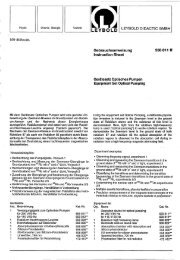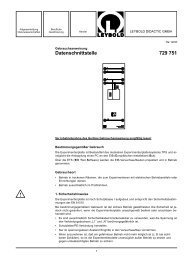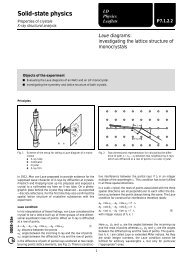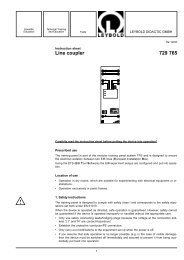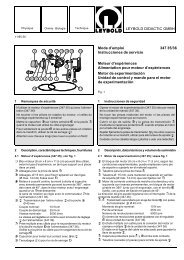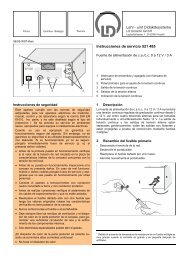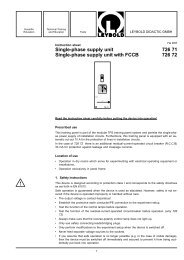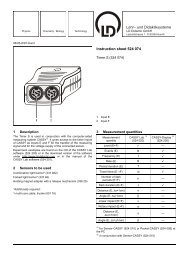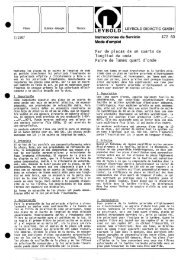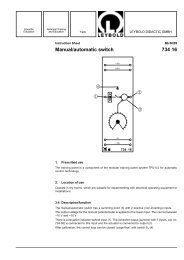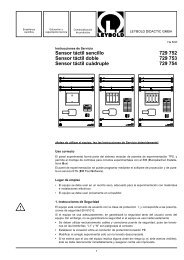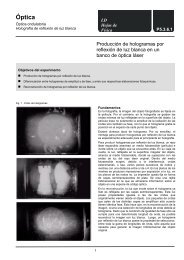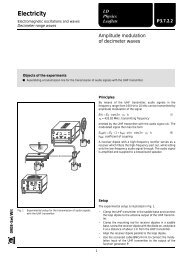Optics - LD DIDACTIC
Optics - LD DIDACTIC
Optics - LD DIDACTIC
You also want an ePaper? Increase the reach of your titles
YUMPU automatically turns print PDFs into web optimized ePapers that Google loves.
P5.4.5.1 <strong>LD</strong> Physics Leaflets<br />
The two hyperbolas with the path difference �m+1 = (m + 1) ⋅ �<br />
move to the center at a voltage U1 (see Fig. 5); thus, the center<br />
is dark. When the voltage is increased further, the two hyperbolas<br />
change over to the second hyperbola set and there<br />
become continuously larger. At a voltage U2 the next two<br />
hyperbolas move across the center to the other hyperbola set,<br />
the following two at a voltage U3 and so on. The interval<br />
between the voltages U1, U2 and U3 corresponds to twice the<br />
half-wave voltage (see below).<br />
When the polarity of the voltage is reversed, the hyperbolas<br />
move in the opposite direction. Thus, the difference of the main<br />
refractive indexes no – ne increases or decreases due to the<br />
Pockels effect, depending on the polarity of the voltage.<br />
c) Determining the half-wave voltage:<br />
Table 1: Measurement results for determination of the halfwave<br />
voltage<br />
U<br />
kV<br />
0.0 Dark<br />
0.52 Bright<br />
1.01 Dark<br />
1.52 Bright<br />
1.91 Dark<br />
Brightness on translucent<br />
screen at the marked<br />
location<br />
At the values for the voltage U given in Table 1, the intensity of<br />
the lines at the marked points in the interference pattern<br />
change from bright to dark, as the path difference between the<br />
ordinary and the extraordinary partial beam changes by onehalf<br />
the wavelength. The difference between these voltages is<br />
the half-wave voltage U�. This has a value of approx. 0.5 V.<br />
The change in the birefringence �no – �ne after applying the<br />
half-wave voltage is very small. Using equation (I), we can<br />
calculate<br />
�<br />
2 = d ⋅ (�no − �ne), (II)<br />
and obtain<br />
�no – �ne = 16 ⋅ 10 –16<br />
Bibliography<br />
[1] M. Born and E. Wolf, Principles of <strong>Optics</strong>, Pergamon Press<br />
Fig. 5: Changes in the conoscopic interference image due to<br />
the Pockels effect; the respective hyperbola of the interference<br />
order m + 1 are emphasized with bold lines<br />
<strong>LD</strong> <strong>DIDACTIC</strong> GmbH ⋅ Leyboldstrasse 1 ⋅ D-50354 Hürth ⋅ Phone (02233) 604-0 ⋅ Telefax (02233) 604-222 ⋅ E-mail: info@ld-didactic.de<br />
© by <strong>LD</strong> <strong>DIDACTIC</strong> GmbH Printed in the Federal Republic of Germany<br />
Technical alterations reserved



